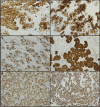Ovarian endometrioid carcinoma with a sex cord-like pattern: a morphological, immunohistochemical, and molecular analysis
- PMID: 38418687
- PMCID: PMC11876222
- DOI: 10.1007/s00428-024-03743-6
Ovarian endometrioid carcinoma with a sex cord-like pattern: a morphological, immunohistochemical, and molecular analysis
Abstract
Sex cord-like endometrioid carcinoma (SCLEC) is an uncommon entity which may constitute a diagnostic challenge. This study aimed to perform a clinicopathological, immunohistochemical, and molecular reappraisal of ovarian SCLEC. Consecutive ovarian SCLECs cases from a single institution were reviewed during a 13-year period. Twenty-three immunohistochemical markers were tested; 10 genes were analyzed by next-generation sequencing. Nine cases of ovarian SCLEC were identified. Mean patient age was 65.7 years; three cases showed extraovarian extension. Architectural pattern included sertoliform (n = 2), granulosa-like (n = 2), and mixed granulosa-like/sertoliform (n = 5). Eosinophilic changes accompanied by increased nuclear atypia were observed in four tumors. Endometrioid features (glands, squamous/morular differentiation) were observed in six cases. Most tumors were positive for cytokeratin-7 (8/9), EMA (9/9), estrogen and progesterone receptor (9/9), CD10 (7/9, including a luminal pattern reminiscent of mesonephric neoplasms), nuclear β-catenin (8/9), and CDX2 (8/9). A minority of cases showed block-type p16 pattern (2/9), PAX8-positivity (3/9), and non-diffuse positivity for WT1 (1/9), inhibin (1/9), chromogranin (1/9), and synaptophysin (2/9). All cases were negative for GATA3, TTF1, calretinin, and SF1. Ki67 range was 15-90%. Six cases showed CTNNB1 exon 3 mutation. Eight cases were of "no specific molecular profile" (NSMP) and one was p53-abnormal. In conclusion, SCLECs frequently exhibit a mixed sertoliform/granulosa-like architecture and express epithelial markers, hormone receptors, nuclear β-catenin, and CDX2, with luminal CD10 positivity and CTNNB1 mutations. PAX8 expression is often lost, while other mesonephric, sex cord, and neuroendocrine markers are negative.
Keywords: Endometrioid carcinoma; Genomic; Immunohistochemistry; Sertoliform; Sex cord; TCGA.
© 2024. The Author(s).
Conflict of interest statement
Declarations. Ethics approval: This study was based on retrospective analyses of routine archival formalin-fixed, paraffin-embedded tissue. All patients provided a written consent for the use of their biological specimen for research purpose. The study was conducted in agreement with the Declaration of Helsinki and the indications of Italian Legislative Decrees no. 196/03 and 101/18. All data were anonymized. No external funds were received for this study. The authors declare no conflict of interest.
Figures



References
-
- Malpica A (2016) How to approach the many faces of endometrioid carcinoma. Mod Pathol 29(1):S29-44 - PubMed
-
- Young RH, Prat J (1982) Scully RE (1982) Ovarian endometrioid carcinomas resembling sex cord-stromal tumors. A clinicopathological analysis of 13 cases. Am J Surg Pathol. 6:513–22 - PubMed
-
- Roth LM, Liban E, Czernobilsky B (1982) Ovarian endometrioid tumors mimicking Sertoli and Sertoli-Leydig cell tumors: sertoliform variant of endometrioid carcinoma. Cancer 50(7):1322–1331 - PubMed
-
- Eichhorn JH, Young RH, Clement PB (1996) Sertoliform endometrial adenocarcinoma: a study of four cases. Int J Gynecol Pathol 15(2):119–126 - PubMed
-
- Fujibayashi M, Aiba M, Iizuka E, Igarashi A, Muraoka M, Takagi K (2005) Granulosa cell tumor-like variant of endometrioid carcinoma of the ovary exhibiting nuclear clearing with biotin activity: a subtype showing close macroscopic, cytologic, and histologic similarity to adult granulosa cell tumor. Arch Pathol Lab Med 129(10):1288–1294 - PubMed
MeSH terms
Substances
LinkOut - more resources
Full Text Sources
Medical
Research Materials
Miscellaneous

